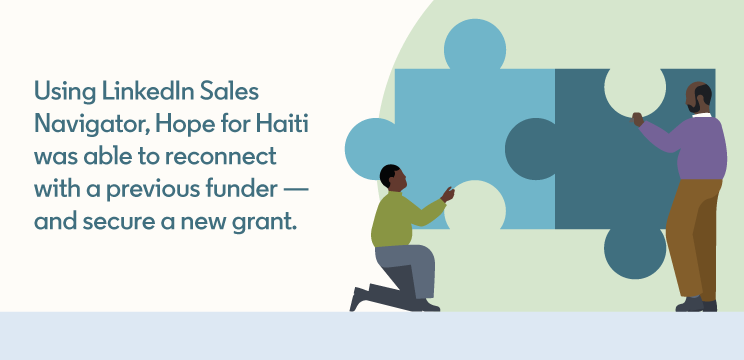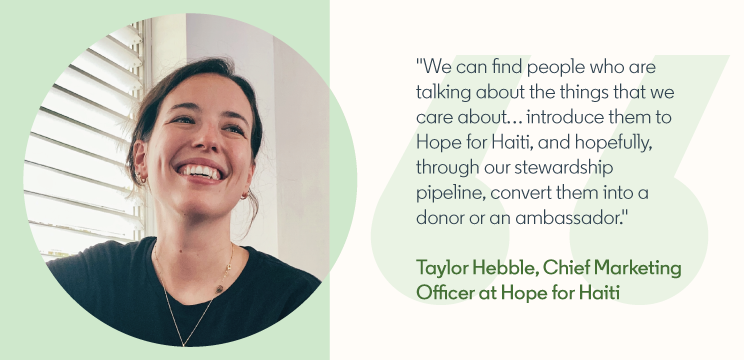
How One Small Nonprofit Makes the Most of LinkedIn for Fundraising and Media Outreach
For 35 years, Hope for Haiti has sought to improve quality of life for the Haitian people, working with community leaders in rural areas to increase access to healthcare, education, clean water, and economic development opportunities. This mission is delivered by a team of almost 150 on-the-ground staff members in Haiti, backed by a partnership between the organization’s small but mighty fundraising and marketing departments in the U.S.
“Development and marketing work very closely together — hand in hand — at our organization,” explains Taylor Hebble, Chief Marketing Officer at Hope for Haiti. “Our CEO likes to say everyone's a fundraiser on our staff, and I think that that's proven true.”
Taylor began her career at Hope for Haiti in the fundraising and development team before pivoting to marketing — and this isn’t the only connection between the two departments. Both teams leverage LinkedIn Sales Navigator to find and connect with the right people, whether that’s a potential donor or foundation professional, an important press contact, or someone else who can help.
Finding gateways to foundations
Hope for Haiti adopted Sales Navigator about five years ago on the request of a major gifts officer. Since then, the solution has become a key component of the development team’s efforts to diversify its funding base.
After identifying charitable foundations with giving priorities that align with Hope for Haiti’s mission, the development team rely on Sales Navigator’s powerful search features to find a “gateway person” — someone who can help the organization bring a more tailored and strategic request to the foundation. From there, they often use InMails to establish a connection directly on LinkedIn.
“We try all approaches [to reach out to these contacts], from the traditional to the non-traditional and everything in between,” says Stephanie Jepsen, Chief Development Officer at Hope for Haiti. “Some of those approaches go unanswered, or into the email abyss. But sometimes with LinkedIn… people are more receptive and willing to respond. Even if it’s a short response, we’ll take it. We’ve opened a line of communication.”
Sales Navigator hasn’t just helped the team to build new connections with potential funders. It’s also proven effective for reigniting old relationships that have fallen to the back burner.

For example, after moving to Washington, D.C., Stephanie decided to try and reconnect with a local foundation that Hope for Haiti had once had a strong relationship with, before losing touch. This family foundation had no staff to answer the phone, and the development team was not sure if their communications were received. Later, Stephanie would learn that the foundation had updated its contact information. But using Sales Navigator, she was able to easily re-connect with another family member at the foundation and naturally restart the conversation.
“She immediately responded,” Stephanie says of the contact. “I invited her to attend a special panel we were hosting, and then they invited me to send in a proposal that ultimately led to a new opportunity for funding, and then a grant.”
Bridging the gap between marketing and fundraising
It’s not just foundation staff that Hope for Haiti uses Sales Navigator to connect with. On the marketing side, Taylor and her team regularly leverage the solution’s advanced search filters to spot people who seem passionate about their cause.
“We have fundraising campaigns that really rely on advocates and ambassadors,” Taylor says. “We can find people who are talking about the things that we care about… introduce them to Hope for Haiti, and hopefully, through our stewardship pipeline, convert them into a donor or an ambassador to help us share both what we’re doing and what we need support to be able to do.”
The marketing team also turns to Sales Navigator for media outreach. Taylor has found that LinkedIn tends to be more up to date than traditional media databases because journalists regularly refresh their LinkedIn profile when they switch jobs. This allows the team to quickly establish relationships with journalists and news outlets, which they can then grow over time by providing mutual value, like responding to requests for background information on topics where Hope for Haiti has subject matter expertise.
“So much of media is relations based, just like development,” Taylor says. “[We] want to steward those relationships so that Hope for Haiti is top of mind when something happens in Haiti or in international development.”

Advice for other nonprofits: Use every tool at your disposal
The marketing and development teams at Hope for Haiti have found countless ways to streamline and enhance their work with Sales Navigator. For other nonprofits looking to get the most out of LinkedIn, they have five top tips to share:
Make a habit of connecting. One of the best ways to grow your organization’s collective network is to connect with people on LinkedIn after you meet them. Hope for Haiti has streamlined this process by creating business cards that include two QR codes — one leading to the team member’s personal LinkedIn profile, and the other to the organization’s website. “It’s such a game changer in conversations,” Stephanie enthuses. “‘Here’s my card, connect with me on LinkedIn.’ [...] They don’t have to go search for me. You’re making it easier to take the next step.”
Find your champions. When using Sales Navigator for corporate fundraising, Hope for Haiti first identifies target companies, then looks for employees at those companies who seem like they might be interested in the work Hope for Haiti is doing, regardless of their role. “In a larger company, the ask as an ambassador is so much easier when it’s coming from within,” Stephanie explains. “So connecting with people that you think are aligned with the cause… and then giving that employee the tools to take it to the next level — that’s been huge.”
Don’t be afraid to experiment. Hope for Haiti recognizes that different audiences respond to different kinds of content. That’s why the marketing team is always experimenting with new methods of sharing information, from hosting LinkedIn Live Events to launching a LinkedIn newsletter. “We saw 3,000 subscribers within the first month and a half,” says Alexa Nargi, Hope for Haiti’s Digital Media Specialist, who created the newsletter. “That was really exciting for us… We know that all of those people who have opted into the newsletter are getting the notification every time we publish and that they’re caught up with everything it is that we’re doing.”
Remember to tag. Tagging donors in appreciation posts is a simple yet effective way to recognize and celebrate their contributions. For Hope for Haiti, the LinkedIn tagging feature is also a critical tool for rapidly amplifying fundraising campaigns during times of crisis. “We’re able to alert our advocates, partner organizations, board members, and team members of what’s going on — and that this is urgent and needs to be shared,” Taylor says. “They know that if they get a tag from Hope for Haiti… they’re going to hit repost and then it’s going to go out to their whole network. [...] I'm using everything at our disposal to try to get the word out as quickly and as widely as possible.”
Plug into the broader nonprofit community. Many nonprofit professionals share their insights on LinkedIn. Taylor recommends not only tapping into this knowledge, but contributing to it by sharing thought leadership content from your personal LinkedIn profile. “Some people think of the nonprofit community as very competitive and that we’re all going after the same funds,” she says. “But that’s not always the case — someone can give to disaster relief and cancer at the same time. So being able to share these best practices and build those connections within the community, I think, is so important.”
To learn more about how your organization can use LinkedIn Sales Navigator to make valuable connections, contact us today.

